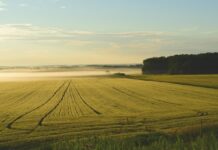Wow, what a spring growing season we had.
In my last article I suggested that you start grazing in the spring when the grass was 2 inches tall. I also mentioned that waiting until the grass was taller would let the spring growth get ahead of you and you might never catch up with it.
The question. I don’t know of very many grazers this year who were able to keep up with the growth no matter how early they started grazing. The question is what do we do with the overmature pasture and hay we have to contend with now and as our winter feed supply?
Unless you were extremely lucky with your timing in harvesting your excess forage this spring, you probably have an abundance of poor quality hay to help you get through the coming winter.
I would suggest that you pull forage samples from each batch of hay you made this year and record where it is stored and how much of that type of hay you have.
While that may not seem important to you right now, it can be extremely important to your livestock this winter.
Resource. The Ohio State University Fact Sheet ANR-002-98 “Forage Testing for Beef Cattle” will give you guidance in how to sample your forage as well as the nutrient requirements for various types of animals.
By identifying how much of what quality hay you have now, you can plan your feeding strategy to use the best quality forage for the animals with the highest demands. You can also identify when and if supplemental feed, particularly feeds high in energy, may be needed.
Explore your options for high quality supplements. It may be that purchasing some corn and/or soybean meal to feed along with your existing hay is the best option, but how can we make that call if we don’t know what we need or what is available.
Options. Consider planting some turnips, oats or rye to graze into the fall and early winter. With proper fertilization and stockpiling (allowing your excess forage growth to accumulate in the field for later grazing) the fall growth, you will be able to graze high quality forages well into the cold weather.
Remember that controlling the amount the animals have access to each day will limit the amount they waste.
If your pastures are like most I have been seeing with lots of seed heads and a growing number of weeds taking advantage of the surplus rains in May and June, then I suggest clipping the excessive growth.
This will allow the plants to return to a vegetative growth stage rather than setting there in a mature state with ever decreasing quality.
It is also time to think about fall fertilization with nitrogen to stimulate the high quality growth we need for stockpiling the extra growth into the winter.
Decide which fields are best suited to fall and winter grazing then plan your fertility program to take advantage of what these fields can offer.
Get involved. To share your experiences and learn from your neighbors, consider participating in an upcoming grazing school or pasture walks. Contact your local Natural Resources Conservation Service, Soil & Water Conservation District or Extension Office personnel and ask them for information or suggestions.
Talk with other farmers who have made the switch to Management Intensive Grazing.
The No. 1 thing is to start the process and learn as you go. The weather, changing seasons, etc. make each year different, and give us never ending learning opportunities.
Expert advice. To learn more about grazing, come visit with nationally known grazing expert, Jim Gerrish. He will be a featured speaker for an advanced grazing school in Carroll County on Sept. 26, and at the Carroll County Country Living Days on Sept. 27.
(The author is a grazing lands conservationist with the USDA Natural Resources Conservation Service.)












